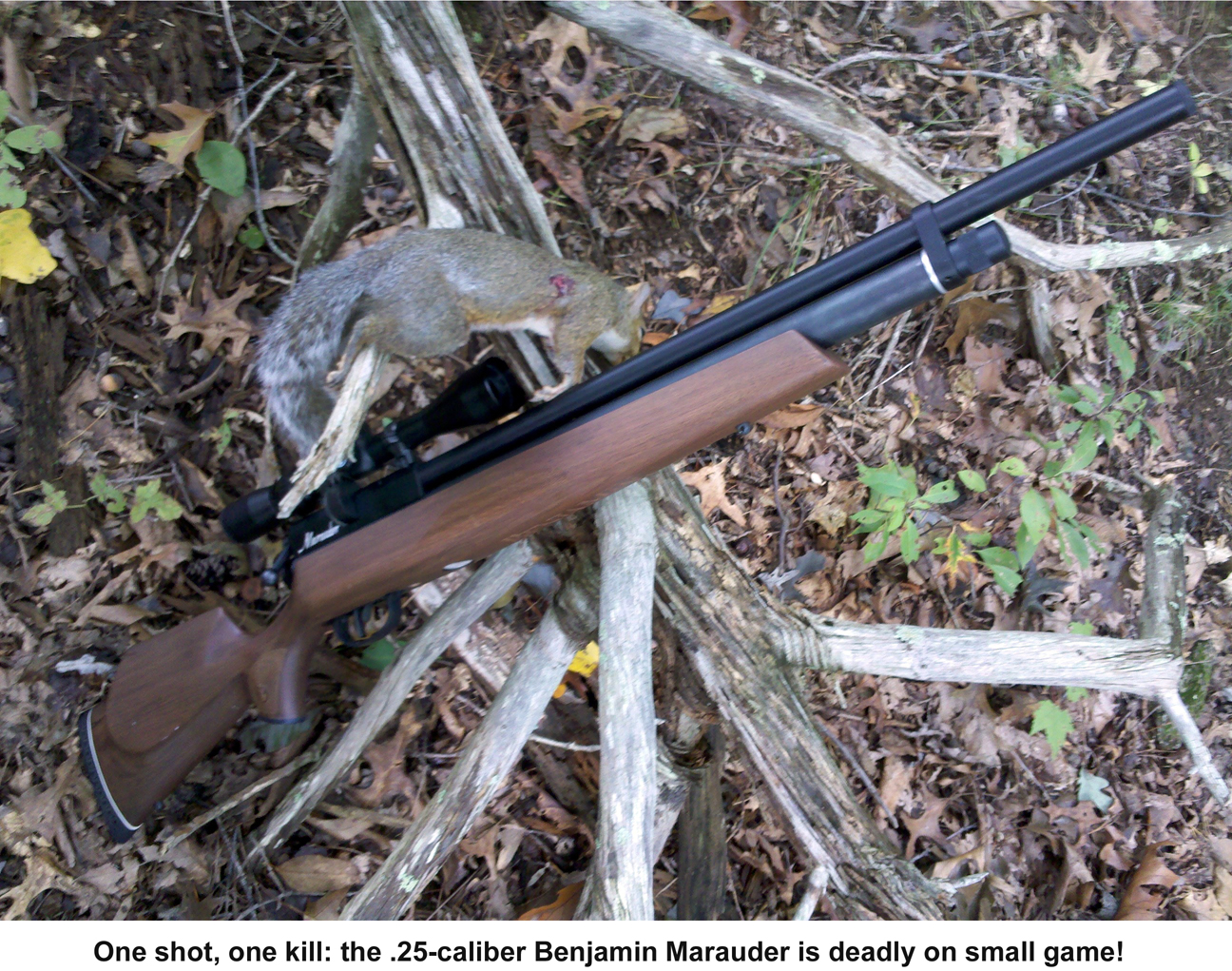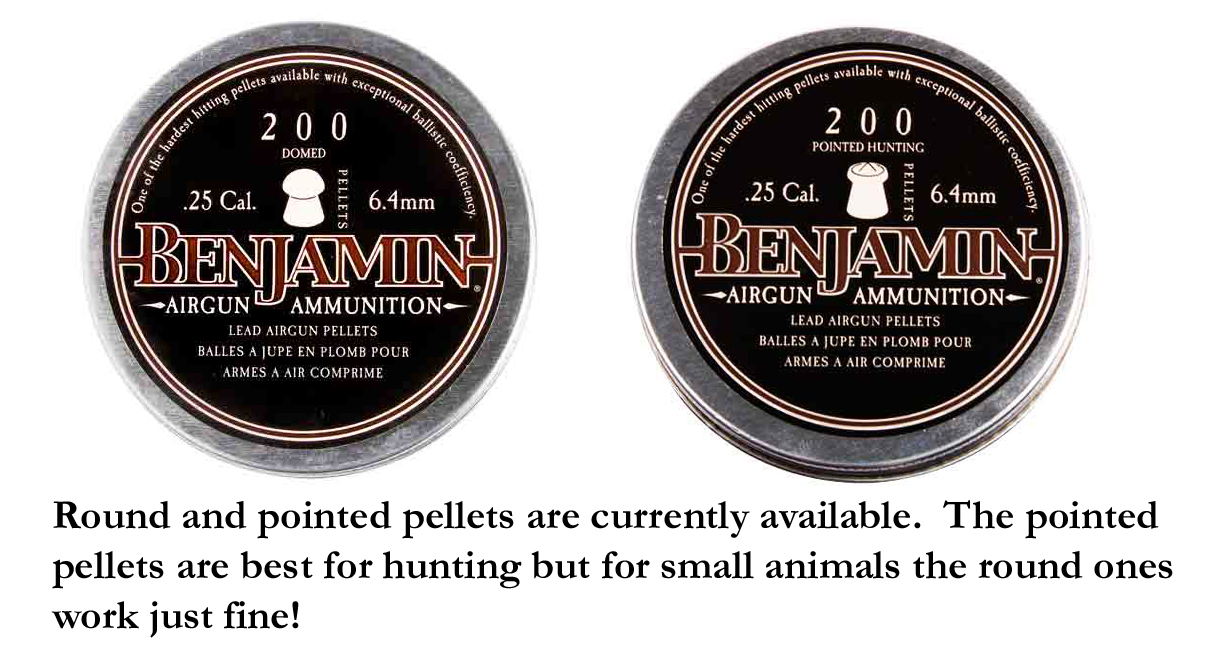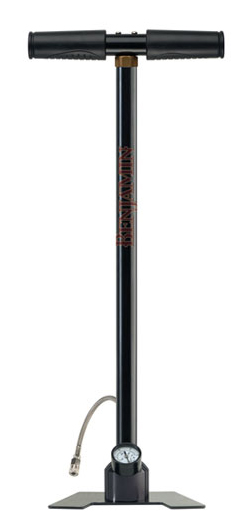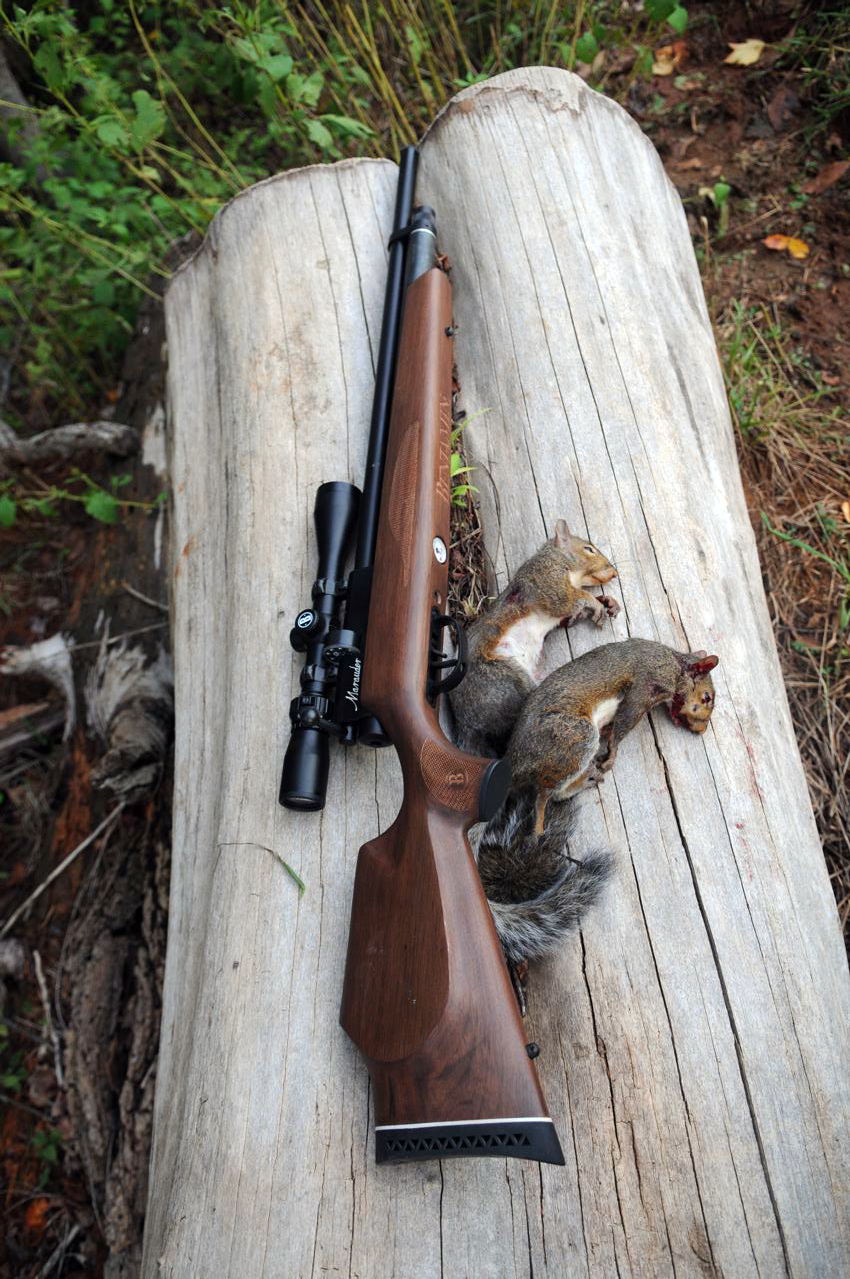
OR, IT AIN'T THE BB GUN YOU GREW UP WITH!

Modern air rifles are a far cry from the low-powered BB guns of my long-gone youth. Airgun makers still produce BB guns, but the "adult" airgun market is ever-growing, so they also produce very sophisticated precision instruments for that segment. The accuracy of such guns within their effective range is as good or better than most target grade firearms, and they have many real advantages over firearms. Most of them are very quiet, which translates to less chance of spooking game or annoying neighbors; yet the right ones are amply powerful for clean kills on small animals. Another significant advantage of airguns is that often they can be used in places where firearms can’t. Many communities have local ordinances against discharging firearms that exempt airguns (some don't, so check your locality’s restrictions). This makes them ideal for “backyard safaris” (when appropriate safety measures are taken, of course) as well as for pest control.
Airguns suitable for hunting break down into a few major operating categories: manual pneumatics (often referred to as “pump-up”); precharged (PCP) pneumatics; and spring-air guns. The “pump up” type is typically a single shot, whose name is descriptive of the way it works: a lever is used to fill an air chamber, whose compressed content is used to discharge the pellet. “Pre-charged” pneumatics have an air reservoir filled by a hand pump or from a larger source of high-pressure gas. They are often repeaters. Spring-air guns are single shots using a lever to compress an internal spring that drives a piston at the moment of firing, generating pressure behind the pellet. (Guns powered by compressed carbon dioxide are usually less powerful than these types, typically unsuited to any kind of hunting, and won’t be given further consideration here.)
The most common calibers for airguns are .177 and .22, though other options exist. The .20 caliber has long had its own following, though it’s nowhere near so common as the first two. In recent years .25 caliber rifles have become more common and readily available, thanks to the development of very powerful pre-charged pneumatics, most especially the hottest gun on the market, the .25 caliber Benjamin Marauder from Crosman Corporation.

Airguns for hunting should be in the larger bores. The .177 guns are suitable only for the smallest game, and then only under ideal conditions. Squirrel-sized animals can cleanly be killed with .177 caliber rifles (especially those generating high velocities) but to ensure a clean kill even on these little guys, head shots are a necessity. Body hits with a .177 will kill, but often not immediately, resulting in lost animals who die slowly. In my opinion, the .177 is barely tenable as a hunting caliber, and then only for an expert who can pick and choose his shots, and then only when using a gun generating velocities over 1000 fps. Most pneumatics and spring guns will meet this standard, but honestly, I can’t recommend the .177 for anything other than target work.
A powerful .22 caliber air rifle using heavy pellets is a far better choice for the hunter than any .177, and a .25 is better still. Larger calibers allow clean kills with properly-placed body hits, as the picture above attests. Again, shot placement has to be the prime consideration; but most high-grade pneumatic and spring powered guns are capable of putting a pointed hunting pellet entirely through the body of a squirrel-sized animal. Penetration is almost invariably adequate with larger calibers.
Velocity in and of itself isn't and can’t ever be an adequate substitute for power and penetration. Yes, a high-velocity pellet (even a .177 pellet) has high "paper" energy: but lightweight pellets lack momentum. A “heavy” .177 pellet is lighter than the normal .22 pellet and far lighter than a .25 pellet. Even with a very high muzzle velocity (say, 1100-1200 fps) light pellets lose speed rapidly. Their terminal performance—the only thing that counts in hunting—will be impaired compared to heavier pellets that may move more slowly at the muzzle but retain energy better at the target.
Very few American jurisdictions consider airguns, even powerful ones, to be firearms. Nor does the Federal government restrict them in any way under the Gun Control Act. With few exceptions high-powered air rifles rifles suitable for hunting can be purchased and freely moved across state lines without restrictions. Most states permit the use of airguns as hunting weapons, in some form or another. More are joining the list: New York recently re-wrote its hunting regulations to allow the use of airguns on small game. Airguns are legal for use in hunting in Virginia. So long as a hunter understands the limitations and capabilities of his airgun, he will find he’s not seriously handicapped using one in the woods.

The Benjamin Model 392 in .22 caliber (right) is an old standby, a single-shot pump-up pneumatic whose design has stood the test of time. It’s pretty much the standard to which most other airguns have been measured (until now). As a means of keeping the corn crib free of vermin, the barn rafters free of pigeons, and other sorts of pest control applications, the .22 caliber Model 392 has proven its worth. It moves a 7.2 grain pointed hunting pellet at up to 650 feet per second, and at short range will reliably take very small animals. Many a “birdseed pirate” has met his fate at the business end of a Model 392! But today there is an even better and more suitable gun for the small game hunter.

I had an opportunity to test one of the brand-new .25 caliber Benjamin Marauder airguns, introduced to the shooting public at the January 2010 SHOT Show. The Marauder (or “M-Rod,” in the slang of the airgun aficionado) is the hottest thing on the market, and deservedly so. It’s a quality high-performance rifle at a very affordable price. It has all the advantages of large caliber, high muzzle energy, and great accuracy: but it comes without the stiff price tag typical of high-end products of other manufacturers. The .25 Marauder takes the hunting airgun to a whole new level: pest control in a silo or barn is at ranges of maybe 25 to 50 feet. In the squirrel woods, a shot at 25 to 35 yards is more the norm. To reliably “reach out and touch someone,” a more powerful gun with a greater reach is needed, and the Marauder fills that niche admirably.
A rifle like this is of necessity fitted with a scope, a metter that requires some thought. Most air rifles will accept a scope, but generally it has to be one specifically designed for air rifles (especially true of scopes for spring-air guns). The Marauder is intended to mount a scope (and in fact is sold without any form of open sights at all), with the receiver grooved for tip-off mounts of the type common on .22-caliber firearms. The best part: since this is a PCP design, the damaging “double recoil” is lacking. Any scope in any mount suitable for use on a .22 rifle can be used safely on the Marauder.
When I received my test rifle I had a “spare” Bushnell scope with tip-off mounts on hand and fitted that to the gun. It worked perfectly. I had to be somewhat careful in positioning the scope mounts so as not to interfere with the insertion of the Marauder’s 10-shot magazine, but once was done I found that even with a relatively inexpensive scope, the Marauder was easily capable of less-than-dime-sized groups at 25 yards’ distance. That’s plenty enough accuracy for even the smallest of game! With a “better” scope and/or a higher power one, I would be very surprised at anything less than sub-MOA performance. The barrel has a slight constriction at the muzzle end to ensure a tight fit around the pellet, which aids in keeping muzzle velocity uniform, and hence enhances accuracy.
The Marauder is QUIET. Very quiet, thanks to a built-in sound moderator sleeve around the barrel. Many high-powered air rifles sound almost like a firearm when they go off, but the Marauder sounds like…well, like an airgun. Subjectively I think the Model 392 is a little louder. No one will ever be disturbed by its mild report, a point that will not be lost on the squirrel hunter. It’s well known that if you take one squirrel from a group, sitting quietly and waiting a bit often convinces the others to get over their initial fright and come back out. The low noise level of the Marauder helps the hunter exploit this behavior.
Another really important feature of this gun for the hunter is that it's a repeater. A rapid second shot isn’t possible with air guns that have to be pumped up or “broken” to reload. In casual shooting this isn’t an issue, but the Marauder’s multi-shot capability is a real advantage in hunting, where sometimes a rapid follow-up shot is needed. Ideally we don’t want to have to shoot again, but under field conditions it happens. The bolt requires minimal movement to chamber a new pellet, another consideration of importance in hunting.
The Marauder comes with a multi-shot rotary magazine that’s inserted from the right side of the gun. The magazine design is—pardon the pun—somewhat “squirrely” and takes a bit of practice to become familiar with it, but it works well. I found that the magazine on the test rifle needed some “break in” to move smoothly in and out of its recess, and to seat properly. If the magazine isn’t fully and firmly seated in the well, the bolt won’t cycle, hanging up on the magazine shell, rather than pushing the next pellet into place. These very minor issues were solved completely after one or two shooting sessions, which smoothed off any roughness or “flash” in the plastic housing. A single-shot loading tray that inserts where the magazine does is available as an aftermarket accessory.
The Marauder has power to spare. It is rated at up to 900 feet per second muzzle velocity, which with a .25 pellet weighing 27.8 grains (compared to 7.2 grains for the .17 and 14.3 grains for the .22) gives a muzzle energy figure of 50 foot pounds. This is comparable in performance to the 29-grain .22 Short bullet from a firearm. That’s nothing to sneeze at: the .22 Short is one of the finest and quietest small game rounds that exists, and the .25 Marauder matches its performance easily. This level of performance is adequate for any small game, and with properly placed shots the Marauder .25 will cleanly kill animals the size of a raccoon or an opossum. As a means to dispatch a trapped animal, it would be more or less ideal as well. Where and when it’s legal to shoot birds with a rifle, it’s accurate and powerful enough to take crows and birds of similar size.
 The Marauder uses air compressed to as much as 3000 PSI. It can use CO2 as well, but at lower pressure and the sights will have to be adjusted accordingly. It’s equipped with a pressure gauge in the bottom of the stock that accurately records the internal pressure and serves as well to indicate the degree of consumption of air. I found that 10 rapid shots in succession would deplete the air supply to about 2000-2500 PSI, still more than adequate for hunting. More than 25 shots are needed to see fall-off in performance. But since few shots are fired in a typical hunting day, a morning fill to 3000 PSI will almost certainly serve for the entire time, with no decrease in accuracy or power.
The Marauder uses air compressed to as much as 3000 PSI. It can use CO2 as well, but at lower pressure and the sights will have to be adjusted accordingly. It’s equipped with a pressure gauge in the bottom of the stock that accurately records the internal pressure and serves as well to indicate the degree of consumption of air. I found that 10 rapid shots in succession would deplete the air supply to about 2000-2500 PSI, still more than adequate for hunting. More than 25 shots are needed to see fall-off in performance. But since few shots are fired in a typical hunting day, a morning fill to 3000 PSI will almost certainly serve for the entire time, with no decrease in accuracy or power.
The easiest way to fill the reservoir is from a larger high-pressure source, so Crosman has adapters to do this using a SCUBA tank. But for those who lack access to one, there’s an accessory hand pump (MSRP $200) that is capable of filling the reservoir to the necessary level, albeit at the cost of some physical effort. The pump is a handy thing to have, but if you can fill from a SCUBA tank, so much the better. It takes only a few seconds that way to get the pressure up to the 3000 PSI mark, and the rifle will hold pressure indefinitely. This too, is a feature of the Marauder that suits it to pest control as well as hunting: it can be left pressurized, with the magazine out, and ready to load for use at a moment’s notice. Filling is via a quick-connect/quick-disconnect valve, a very thoughtful touch. If I have a complaint to make about the filling features, it’s that the connecting hose for the hand pump is too short. It requires the rifle to be laid on the ground, making it difficult to watch the pressure gauge carefully.
 The Marauder isn't a small gun. It has a 14-3/4" length of pull on the stock, and a loaded weight of 8-1/2 pounds (scoped), which makes that nice recoil pad even more inexplicable. It's a gun for adults, though one which kids who can handle the length and weight will also be able to use to good effect. A pair of detachable sling swivel bases are provided. I'm not much on slings for shooting, but as an aid to carrying in the field, a detachable sling is highly desirable in a hunting. Most of my own squirrel hunting is done from a stand, and the sling comes off as soon as I sit down to wait. But it's not easy to get my hand around the balance point of the Marauder (especially with a scope on top) so a sling is needed to carry it to the stand site.
The Marauder isn't a small gun. It has a 14-3/4" length of pull on the stock, and a loaded weight of 8-1/2 pounds (scoped), which makes that nice recoil pad even more inexplicable. It's a gun for adults, though one which kids who can handle the length and weight will also be able to use to good effect. A pair of detachable sling swivel bases are provided. I'm not much on slings for shooting, but as an aid to carrying in the field, a detachable sling is highly desirable in a hunting. Most of my own squirrel hunting is done from a stand, and the sling comes off as soon as I sit down to wait. But it's not easy to get my hand around the balance point of the Marauder (especially with a scope on top) so a sling is needed to carry it to the stand site.
The safety catch is a modfied version of the Garand design, a lever inside the trigger guard that is flicked off with the trigger finger by pushing it forward. It's suitable for either right or left-handed use.
Overall, the quality of fit and finish is remarkably good, especially given the modest $510 MSRP. It’s comparable to much more expensive guns from some European makers, guns whose terminal performance isn’t as good as the Marauder’s. The stock is real walnut, and while plain, is very well finished and has a comfortable, satin feel to it. It’s also fitted with a wholly un-needed recoil pad, since the recoil from this gun is negligible. But it’s a nice touch. The underside of the fore-end has the maker’s name carved into it, and the fore-end and wrist are nicely checkered, about the only ornamentation visible. In other words, the Marauder is a working rifle, not a display piece, unlike some $2K guns that frankly, I'd be reluctant to take out in the woods. It's also very, very accurate. One-hole groups at 10 meters are the rule, not the exception. The "choke" in the terminal end of the barrel is a key reason. Keeping all the shots in half an inch at 25 yards is easy.
Crosman is to be congratulated on producing a rugged, handsome, and affordable high-quality airgun. The Marauder will have a major impact on the segment of the airgun market that hunts. And not just airgun hunters, either. The Marauder's ease of use, its accuracy and its power make it suitable as a gun for the farmer or rancher, or the suburbanite who wants to pot the odd woodchuck in his garden without irritating his neighbors. The Marauder has been available in .22 caliber (and .177) for some time, and was cause for excitement, but the .25 offers a significant boost in performance for no more cost. The selection and availability of .25 caliber pellets to date has been somewhat meager, but that situation will change as a result of this rifle becoming available. As more and more hunters find out that there is at last an airgun well suited to their needs (and not just those of target shooters) there will be more companies offering better pellets that further improve the Marauder’s utility.
My sincere thanks to Mr. Mark Taylor for his help in preparing this article.
| HUNTING | GUNS | DOGS |
| FISHING & BOATING | TRIP REPORTS | MISCELLANEOUS ESSAYS |
| CONTRIBUTIONS FROM OTHER WRITERS|
| RECIPES |POLITICS |